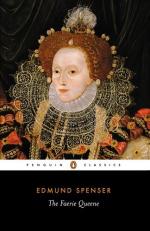3. INTERPRETATION OF THE ALLEGORY.—In the sixteenth century it was the opinion of Puritan England that every literary masterpiece should not only give entertainment, but should also teach some moral or spiritual lesson. “No one,” says Mr. Patee, “after reading Spenser’s letter to Raleigh, can wander far into Spenser’s poem without the conviction that the author’s central purpose was didactic, almost as much as was Bunyan’s in Pilgrim’s Progress.” Milton doubtless had this feature of the Faerie Queene in mind when he wrote in Il Penseroso:—
“And if aught else great bards beside In sage and solemn tunes have sung Of turneys, and of trophies hung, Of forests and enchantments drear, Where more is meant than meets the ear.”
That the allegory of the poem is closely connected with its aim and ethical tendency is evident from the statement of the author that “the generall end therefore of all the booke is to fashion a gentleman or noble person in vertuous and gentle discipline. Which for that I conceived should be most plausible and pleasing, being coloured with an historical fiction, the which the most part of men delight to read, rather for varietie of matter then for profite of the ensample.” The Faerie Queene is, therefore, according to the avowed purpose of its author, a poem of culture. Though it is one of the most highly artistic works in the language, it is at the same time one of the most didactic. “It professes,” says Mr. Church, “to be a veiled exposition of moral philosophy.”
The allegory is threefold,—moral, religious, and personal.
(a) Moral Allegory.—The characters all represent various virtues and vices, whose intrigues and warfare against each other symbolize the struggle of the human soul after perfection. The Redcross Knight, for example, personifies the single private virtue of holiness, while Prince Arthur stands for that perfect manhood which combines all the moral qualities; Una represents abstract truth, while Gloriana symbolizes the union of all the virtues in perfect womanhood.
(b) Religious or Spiritual Allegory.—Under this interpretation the Redcross Knight is a personification of Protestant England, or the church militant, while Una represents the true religion of the Reformed Church. On the other hand, Archimago symbolizes the deceptions of the Jesuits and Duessa the false Church of Rome masquerading as true religion.
(c) Personal and Political Allegory.—Here we find a concrete presentation of many of Spenser’s chief contemporaries. One of Spenser’s prime objects in composing his epic was to please certain powerful persons at court, and above all to win praise and patronage from the vain and flattery loving queen, whom he celebrates as Gloriana. Prince Arthur is a character that similarly pays homage to Lord Leicester. In the Redcross Knight he compliments, no doubt, some gentleman like Sir Philip Sidney or Sir Walter Raleigh, as if he were a second St. George, the patron saint of England, while in Una we may see idealized some fair lady of the court. In Archimago he satirizes the odious King Philip II of Spain, and in false Duessa the fascinating intriguer, Mary Queen of Scots, who was undeserving so hard a blow.




